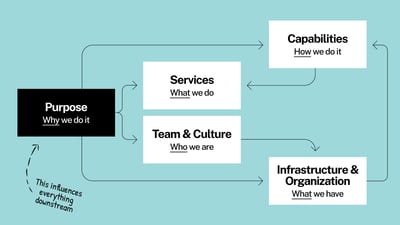A Better Strategy for Making a Better Nonprofit Strategic Plan

Strategic planning is often viewed by nonprofits as a necessary yet expensive and impractical exercise, encouraging at best only incremental rather than meaningful growth.
Several reasons contribute to its ineffectiveness as a true planning document.
First, strategic planning meetings lack structure and can be unproductive.
Some agenda items are over-talked, topics arise that were never on the agenda, and then there’s jawboning, repetitive opinions, interruptions, and sometimes finger-pointing. (A better approach is a strategic planning workshop for nonprofits with growth-focused exercises.)
Second, leaders often lack ground-level context, hindering practical decisions. (Engaging teams, partners, and clients to identify issues and solutions can address this.)
Third, many plans fail to capture and execute ideas effectively. (We use the "How Might We" exercise to turn challenges into actionable steps.)
Finally, prioritizing documentation over action usually results in unwieldy plans that most of us don’t care to read or, by extension, to execute.
In short, nonprofits need a new, more effective strategy to create their strategic plan.
Get Everyone on the Same Page—Literally
Conventional processes involve extensive research, collaboration, and documentation, but often fail to lead to an effective, mission-driven plan.
Instead, keep the strategy simple with ruthless prioritization, clarity, and brevity. Recognize that perfection isn’t possible and that plans should remain adaptable in the face of changing circumstances. Ditch the norm, and let team knowledge, experience, and logic lead the way.
The solution: A one-page strategic plan.
It provides a clear, 30,000-foot view of priorities, objectives, and direction, allowing everyone to align with your nonprofit’s goals. After all, brevity gets the crown when it comes to communicating an overarching strategy to teammates at all levels.
The one-page strategic plan promotes organization-wide buy-in and empowers team members to make decisions aligned with the organization's goals. This should lead to faster, more effective results when it comes to a nonprofit’s impact, performance, and growth.
Align Your Nonprofit Goals Using a Strategic Sprint
Generally taking months, the traditional strategic planning process for nonprofits fails to be succinct, capture ideas, and define realistic, actionable steps because it lacks one vital element: Structure.
A more effective approach is the Strategy Sprint, consisting of just four half-day workshops facilitated over a three-week period.
The workshops employ a variety of structured exercises that enable the leadership team to:
- Align on purpose and critical challenges
- Identify specific actions to overcome the challenges and to achieve success
- Develop a winning, action-oriented strategy capable of real growth
- Inspire the organization and execute a coordinated plan
You won’t even need to take notes during the Strategy Sprint. The week four handoff includes a shareable executive summary that contains all of the structured exercise results, ready for easy reference.
You just need one more thing to help ensure your strategic plan is a true hero.
Uncover Your Best Ideas with Inclusive Policies
The inefficiency of traditional strategic planning often extends to a lack of inclusiveness.
Meetings with unstructured agendas can lead not only to over-talked and off-target topics, but discussions hijacked by more aggressive folks to the exclusion of quieter voices.
Inclusiveness is essential for various benefits, including increased team-wide buy-in and motivation, individual innovation, and organizational efficiency.
To make strategic planning inclusive, nonprofit leaders must create a safe space for sharing ideas, establish boundaries and ground rules, and assign a facilitator to enforce those rules and maintain a bias-free workspace.
Collaborative strategies facilitated with structured exercises help capture new ideas and fresh perspectives from everyone. Your nonprofit thus benefits from a more inclusive strategic plan.
The Strategy Sprint is a speedy yet excellent method for creating such a plan. It also protects against some of the biggest mistakes nonprofits make with traditional strategic planning.
Strategy Sprint for the “Do’s” – Now for a few of the “Don’ts”
Many nonprofits invest significant time and resources into strategic planning, but often make mistakes that render their plans less effective.
Common issues include (a) overly generic goals stemming from vague mission and vision statements, (b) a lack of actionable steps to achieve your nonprofit objectives, and (c) compiling extensive documentation without clear methodologies for addressing challenges.
Other mistakes include the presence of an impossible wish list with too many goals, along with a lack of organization-wide support and ownership that can hinder success.
Lastly, a lack of flexibility to adapt to changing circumstances and the evolving nonprofit landscape in general can render plans obsolete.
And speaking of mistakes, a number of industries use the SWOT process for strategic planning. While determining Strengths, Weaknesses, Opportunities, and Threats can be of notable value, relying on them for a future action plan can lead a nonprofit well astray.
The Pitfalls of SWOT
For one thing, nonprofits often focus on strengths and opportunities, leading to an uncomfortable culture clash when forced to consider weaknesses and threats.
For another, problems using SWOT include elements being too vague or general, ignoring external changes, and oversimplifying the overall analysis.

An additional issue is mixing up causes and effects.
For example, perhaps you’ve concluded that your nonprofit has a weakness in community engagement. However, could that actually be the effect caused by the real weakness, which is limited outreach efforts? Misunderstanding the two can waste resources on the wrong solution.
Other pitfalls involve treating factors as isolated entities, depending on potentially unreliable data, and lacking a hierarchy for prioritizing strengths, weaknesses, opportunities, and threats.
In a nutshell, nonprofits may very well find SWOT analysis inadequate.
To ensure an effective strategy, consider creating an actionable, flexible, and realistic plan with clear objectives and ownership.
Contact CauseMic, and let’s talk about a Strategy Sprint just for you!










